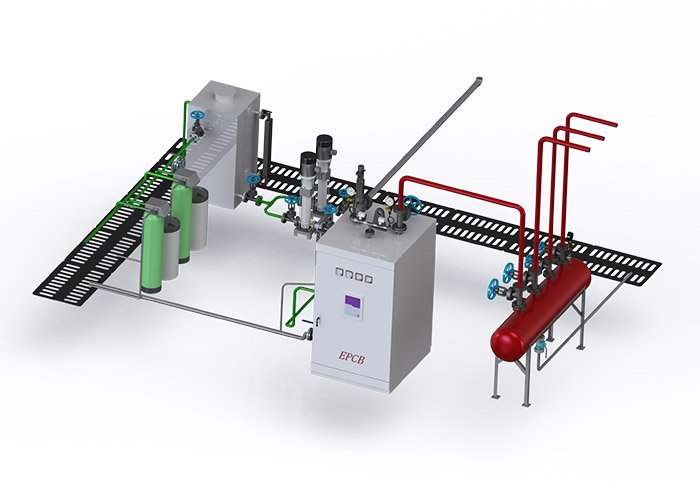Introduction
Textile industry is an important part of global manufacturing industry, involving many links such as fabric production, dyeing and finishing, post-treatment and so on. In this process, the stable supply of heat energy is very important to ensure product quality and production efficiency, and the boiler is the core equipment to provide this heat energy. Whether it is used to heat water, generate steam or maintain the constant temperature environment of production line, boilers play an irreplaceable role in the operation of textile mills.
Specifically, the steam generated by boilers is widely used in key links of textile industry, such as dyeing, printing, setting and drying. For example, in the dyeing process, high-temperature steam helps the dye to penetrate into the fiber evenly and improve the dyeing effect; In the shaping process, the stable heat energy supply ensures that the fabric will not have quality problems due to temperature fluctuation during the shaping process. Therefore, the choice of boiler directly affects the cost, energy efficiency and environmental protection standards of textile production.
However, different types of boilers have differences in thermal efficiency, fuel cost and environmental protection performance. Faced with increasingly strict environmental protection regulations and rising energy prices, textile enterprises need to choose the most suitable boiler type according to their own needs. So, what kind of boilers are usually used in the textile industry? Which boiler can reduce energy consumption and emissions while ensuring production efficiency? EPCB boilers will discuss these problems in depth, and analyze the application of fire tube boilers, water tube boilers and biomass boilers in textile industry.
The Role of Boiler in Textile Industry
In the textile industry, the heat energy provided by the boiler is very important for several key processes, including dyeing, drying and setting. The supply of heat energy not only affects the product quality, but also directly affects the production efficiency and cost control.
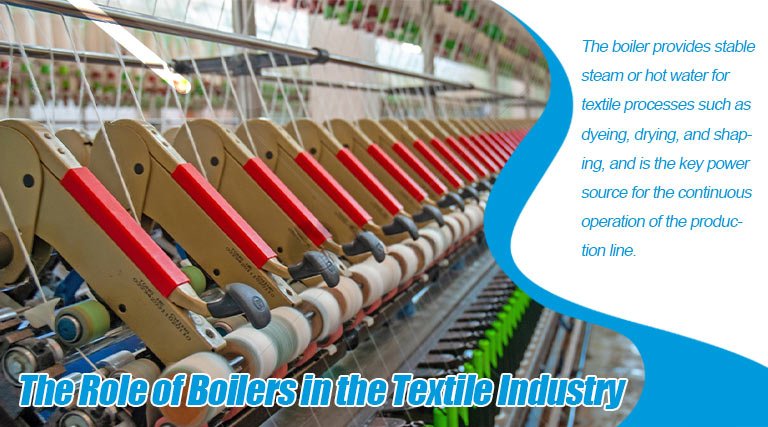
Dyeing process
Dyeing is the core step in textile processing, which usually requires a lot of hot water and steam. The high-temperature steam generated by the boiler can be used for dye dissolution, fiber expansion and dyeing liquid circulation, so that the dye can penetrate into the fiber evenly and improve the dyeing quality. At the same time, accurate temperature control is very important to ensure color uniformity and color fastness, which depends on the stable steam supply of the boiler.
Drying process
Dyed or printed textiles contain a lot of water and need to be dried. The heat energy provided by the boiler passes through the hot air blower or steam drying system, so that the fabric can quickly evaporate water and improve production efficiency. If the heat energy supply is insufficient or fluctuating, it may lead to uneven drying, thus affecting the handle, gloss and overall quality of the fabric.
Setting process
Setting process is the last key link in textile production, and its purpose is to make the fabric reach the ideal size and shape through heating and stretching. High temperature steam or hot air is used to control the shrinkage and morphological stability of fibers. The stable operation of the boiler can ensure the uniform temperature in the setting process and avoid the deformation or irregular shrinkage of the fabric.
The reliability and efficiency of boilers are very important for textile production lines. Stable heating ensures the continuity of production and avoids downtime and economic losses caused by failures; High-efficiency boilers can reduce fuel consumption, reduce operating costs and meet environmental protection requirements; Precise temperature control ensures the quality of dyeing and setting. To sum up, choosing a reliable and efficient boiler system is the key to ensure stable production and product quality.
Traditional Boiler Type: Fire Tube Boiler and Water Tube Boiler
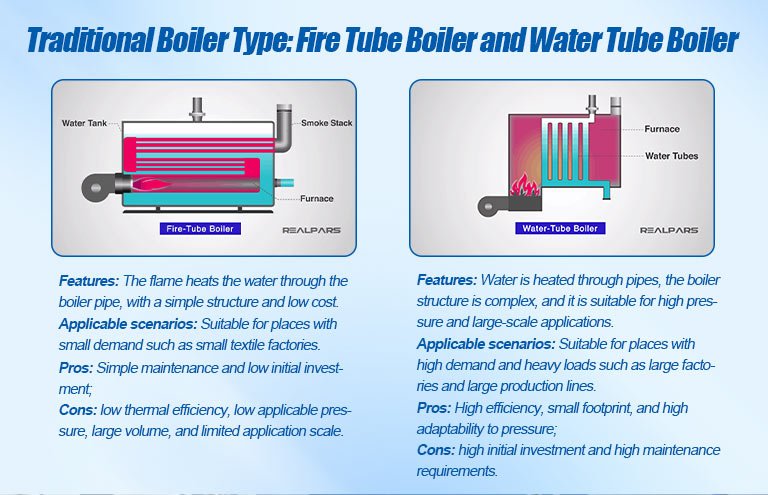
Fire Tube Boiler
Fire-tube boiler is a common industrial boiler. The high-temperature flue gas generated by fuel combustion heats water through the boiler pipeline, thus generating steam. The fire tube boiler has the characteristics of simple structure, convenient operation, low maintenance cost and stable operation, which is especially suitable for small industrial applications. In addition, the boiler is suitable for low-pressure steam production, and has a fast response speed, which can meet the immediate demand for steam supply in the production process.
Fire tube boilers are mainly used in small textile mills and are suitable for production environments with small steam demand. Its stable low-pressure steam supply is especially suitable for dyeing, printing and other processes that do not require high steam pressure, and can meet the basic needs of these processes for heat energy.
The advantages of fire tube boiler are relatively low cost, economical and applicable, and suitable for enterprises with limited budget. In addition, it has compact structure, small floor space and can save production space. At the same time, the boiler has low maintenance cost and convenient maintenance, which is helpful to reduce the long-term operating cost.
However, the fire tube boiler also has some limitations. Its steam pressure and output capacity are limited, so it is not suitable for large factories or production environments with high steam demand. In addition, due to the relatively low thermal efficiency and high fuel consumption, the operating cost is high. For the process that needs high temperature and high pressure steam, the fire tube boiler is difficult to meet the requirements, so enterprises should fully consider its applicability when choosing.
Water-Tube Boiler
Water tube boiler adopts water tube structure, and water flows in the pipe and absorbs the heat generated by combustion to form steam. This kind of boiler is common in large textile mills. Water tube boiler has higher steam pressure and output, which is suitable for large-scale industrial applications and can meet the production needs of large textile factories. Its operation efficiency is high, which can not only effectively reduce energy consumption, but also improve fuel utilization and reduce operating costs. In addition, the boiler is suitable for processes that need to stabilize high-temperature and high-pressure steam, such as high-temperature setting and large-scale dyeing, to ensure the stability of the production process and product quality.
Water tube boilers are suitable for large textile factories and can meet the production environment with large steam demand. Its efficient steam supply capacity makes it especially suitable for high-temperature setting, dyeing and other processes that require high heat energy, ensuring the stability of temperature in the production process, thus improving the processing quality and production efficiency of textiles.
Water-tube boilers have higher thermal efficiency, which can effectively save fuel costs and reduce long-term operating expenses of enterprises. In addition, it can adapt to the rapid load change, and can flexibly adjust the steam supply according to the needs of different production stages to ensure the continuity and stability of production. At the same time, the boiler can provide high-temperature and high-pressure steam to meet the needs of large-scale production, and is especially suitable for processes that require strict heat energy, such as high-temperature setting and large-scale dyeing.
However, the structure of water-tube boiler is more complicated, and the installation and maintenance costs are higher, so enterprises need to invest more funds and technical support in the process of use. In addition, the operation of the boiler needs professional operators to manage, which increases the difficulty of operation and training costs. Compared with the fire tube boiler, the initial investment of water tube boiler is higher, so enterprises need to fully consider the capital budget and long-term benefits when choosing.
Biomass Fired Steam Boiler
With the strengthening of environmental protection regulations and the rising of energy costs, biomass boilers are gradually favored by the textile industry. Biomass boiler is a kind of boiler that uses renewable biomass fuel (such as wood, rice husk, corn stalk, etc.) to generate heat energy. Compared with traditional coal-fired and oil-fired boilers, it has less emissions and more advantages in fuel cost.
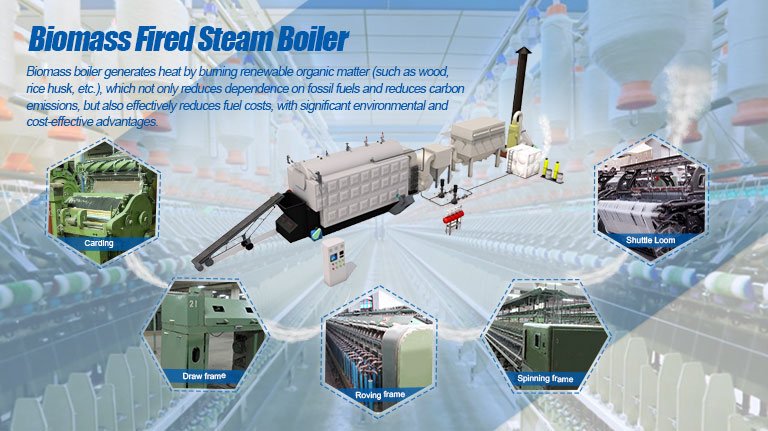
Fuel type of biomass boiler
The fuel of biomass boiler mainly comes from agricultural and forestry wastes, and these fuels are rich in types, including:
Sawdust and sawdust: from wood processing industry, it has good combustion performance and is suitable for stabilizing heat energy supply.
Rice husk and wheat straw: typical representatives of agricultural wastes, with wide sources, are suitable for large textile factories.
Corn stalk: it is economical and easy to obtain, but it may produce more ash during combustion.
Biomass particles: processed and pressed, with high combustion efficiency and convenient transportation and storage.
Environmental advantages
Low carbon emission: Compared with coal-fired boilers, the carbon dioxide emission of biomass boilers is greatly reduced, which helps to reduce the carbon footprint.
Reducing pollutants: The sulfur content in the combustion process of biomass fuel is low, which can effectively reduce the emissions of pollutants such as sulfur dioxide (SO) and nitrogen oxides (NOx).
Compliance with environmental protection laws and regulations: With the strengthening of environmental protection policies in various countries, traditional coal-fired boilers are gradually eliminated, and biomass boilers, as clean energy equipment, meet the requirements of sustainable development.
Cost-effectiveness advantage
Low fuel cost: Compared with natural gas and diesel, biomass fuel is more stable in price and widely available, which is suitable for long-term use.
Energy self-sufficiency: textile enterprises can use their own or surrounding agricultural wastes as fuel to reduce procurement costs.
Government subsidy support: Some countries and regions provide financial subsidies or tax incentives to enterprises that use biomass boilers to further enhance economic benefits.
Apply the scenario
Biomass boilers are suitable for medium and large textile mills, especially for production lines with large steam demand, and also for enterprises wishing to reduce carbon emissions and optimize energy structure. For areas with high energy costs, biomass boilers can reduce long-term operating costs and improve economic benefits by using renewable fuels. Although biomass boiler has many advantages, its fuel storage and supply chain management are still problems to be solved. In order to ensure the combustion efficiency, enterprises need to configure appropriate fuel processing and storage equipment, and regularly maintain the boiler system, so as to prolong the service life and maintain its efficient and stable operation.
Case Study
In order to further explore the practical application of biomass boiler in textile industry, we take a well-known textile enterprise in Asia as an example, which has an annual output of more than 50,000 tons of textiles, mainly exported to European and American markets. In the past, the company used traditional coal-fired boilers as the main source of heat energy, but with the tightening of environmental protection regulations and the rising cost of coal, the company decided to introduce biomass boilers to reduce operating costs and carbon emissions.
Background
Factory scale: covers an area of over 100,000 square meters, and has several production lines for dyeing, setting and printing.
Original boiler system: two coal-fired boilers are used, which consume about 15,000 tons of coal every year and have high carbon emissions.
Selection of new boilers: two 6-ton/hour biomass boilers are introduced, and rice husk and sawdust are used as main fuels.
Achievements after transformation
By using biomass boilers, the textile enterprise greatly reduced operating costs and improved production efficiency. The price of biomass fuel is about 20% lower than that of coal, which saves about $1.2 million in fuel cost every year. The improvement of boiler thermal efficiency also reduces energy waste. The boiler with higher degree of automation has realized more stable heating, increased the qualified rate of dyeing and setting by 8%, shortened the preheating time by 30%, and improved the start-up efficiency. In terms of environmental protection, the annual emission of carbon dioxide is reduced by about 50,000 tons, so and NOx are significantly reduced, and the government subsidizes environmental protection by 500,000 US dollars, which is in line with international environmental protection standards. Thanks to the green transformation and the enhancement of corporate brand image, orders in Europe and America increased by 15%, which was set as a model of green manufacturing by the government.
Challenges and Solutions
Although the boiler plays a vital role in the production process of textile industry, it still faces many challenges in its operation. In order to ensure the efficient and safe operation of boilers, enterprises need to take effective solutions to these problems.
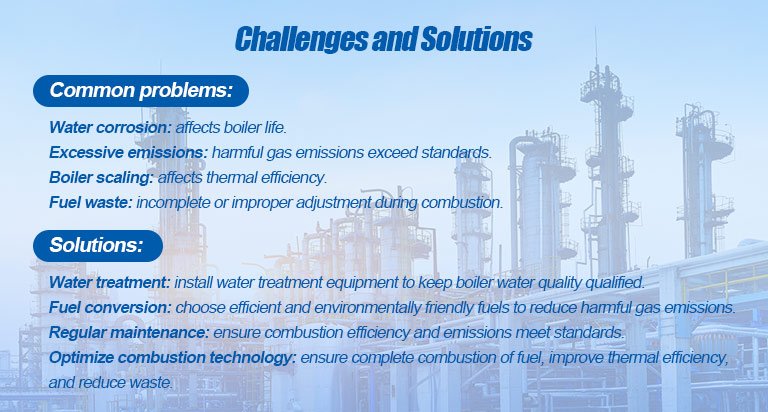
Common Challenges
Water quality corrosion
In the long-term use of the boiler, if the water quality of the water supply is poor, it will easily lead to pipeline corrosion and scaling, reduce the heat exchange efficiency, and even lead to boiler failure. Oxygen and carbon dioxide in water will accelerate metal corrosion and affect boiler life.
Excessive emission
Traditional coal-fired boilers emit high levels of sulfur dioxide (SO), nitrogen oxides (NOx) and soot, which are easy to cause environmental pollution and do not meet the requirements of environmental regulations. If the biomass boiler is not fully burned, it may also produce higher particulate emissions.
The fuel supply is unstable
The fuel of biomass boiler (such as rice husk and sawdust) is greatly affected by seasonality, and the price and supply may fluctuate. Low-quality fuel with high water content will reduce the combustion efficiency of boiler and increase fuel consumption.
Low thermal efficiency
Some old boilers are backward in design and low in heat utilization, which leads to energy waste. The operation and maintenance are not in place, and the carbon deposition and scaling of the boiler are serious, which affects the combustion efficiency.
High maintenance and operation costs
Long-term operation of the boiler needs regular maintenance and overhaul, otherwise it will easily break down and affect production. The skill level of operators is uneven, which may lead to inadequate boiler operation management and increase operating costs.
Solution
Water treatment and anticorrosion technology
Install water softening equipment before the boiler enters the water to reduce calcium and magnesium ions in the water and reduce the scaling risk.
Use oxygen removal equipment or add chemicals (such as hydrazine) to remove oxygen from water and reduce corrosion.
Regularly clean boiler pipes to prevent scaling from reducing heat exchange efficiency.
Emission control and environmental protection optimization
Upgrade boiler combustion technology and adopt low nitrogen burner to reduce NOx emission.
Install efficient dust removal equipment (such as bag filter and electrostatic precipitator) in the boiler tail gas emission system to reduce smoke and dust emission.
Wet or dry desulfurization equipment is adopted to reduce SO emission and ensure compliance with environmental protection standards.
Optimize the fuel supply chain
Establish a long-term and stable fuel supply chain and choose diversified suppliers to reduce the risk of raw material shortage.
Fuel pretreatment technology (such as drying and biomass briquetting) is adopted to improve combustion efficiency.
Use intelligent fuel proportioning system to adjust combustion parameters according to fuel characteristics to ensure efficient combustion.
Improve thermal efficiency
Choose high-efficiency boiler equipment, such as condensing boiler, to improve energy recovery and utilization rate.
Waste heat recovery technology, such as installing waste heat recovery device, is adopted to heat boiler feed water or production process.
Regularly overhaul and clean the boiler to ensure the surface of the heat exchanger is clean and reduce heat loss.
Intelligent management and maintenance
Adopt boiler automatic control system to realize accurate adjustment and improve operation efficiency.
Remote monitoring of boiler operation data, timely detection of anomalies, to avoid failures.
Train operators regularly to improve boiler operation and maintenance skills and reduce human operation errors.
Conclusion
The demand for boilers in textile industry mainly focuses on three aspects: high efficiency, stability and environmental protection. Fire tube boiler is suitable for small and medium-sized factories, with simple structure and low cost, but limited production capacity; Water-tube boiler is suitable for large-scale production, with high efficiency and large steam output, which can meet the needs of complex processes; Biomass boiler is favored by environmental protection enterprises because of its low carbon and energy saving advantages, but it is necessary to ensure a stable fuel supply.
Under the background of stricter environmental regulations, biomass and natural gas boilers have become the mainstream choice because of their low emissions and high efficiency. EPCB boilers can provide customized solutions according to the needs of different factories, covering fire pipes, water pipes, biomass and other types. They have the advantages of high thermal efficiency, intelligent control and environmental protection, helping enterprises to reduce operating costs, improve production efficiency, meet international environmental protection standards, and help textile enterprises move towards green manufacturing.
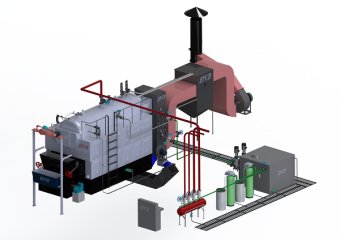 Steam Boiler
Steam Boiler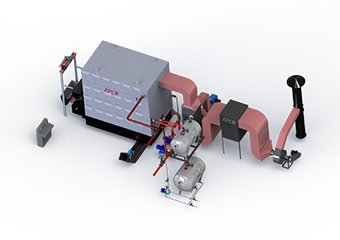 Thermal Oil Boiler
Thermal Oil Boiler Hot Water Boiler
Hot Water Boiler Steam Boiler
Steam Boiler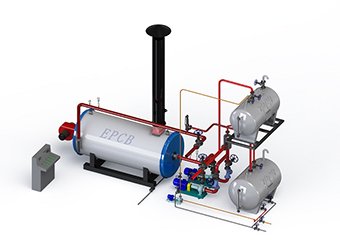 Thermal Oil Boiler
Thermal Oil Boiler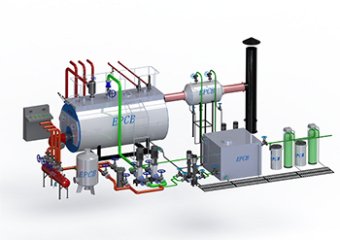 Hot Water Boiler
Hot Water Boiler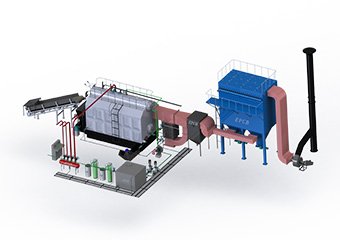 Steam Boiler
Steam Boiler Thermal Oil Boiler
Thermal Oil Boiler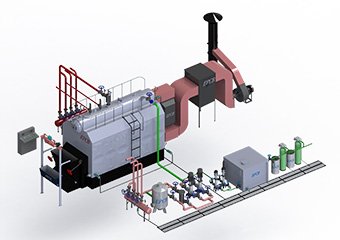 Hot Water Boiler
Hot Water Boiler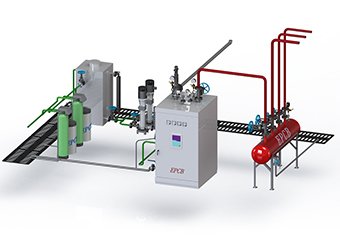 Steam Boiler
Steam Boiler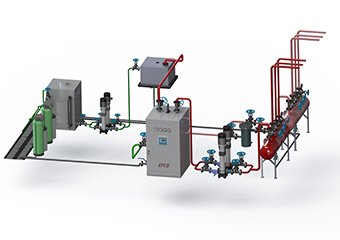 Hot Water Boiler
Hot Water Boiler


















